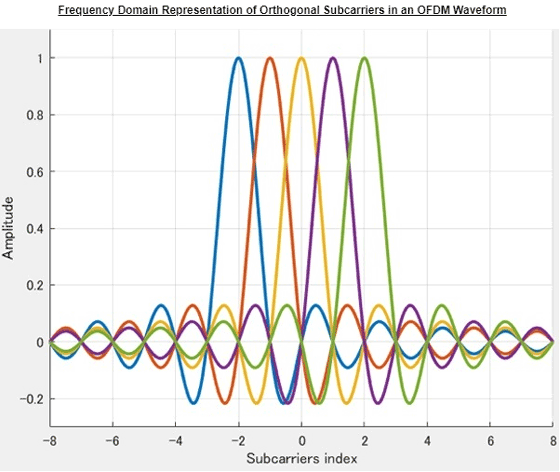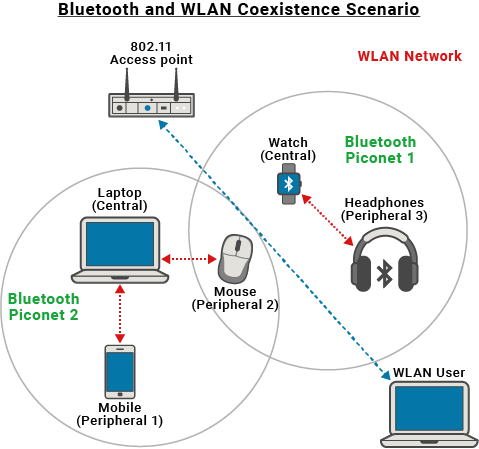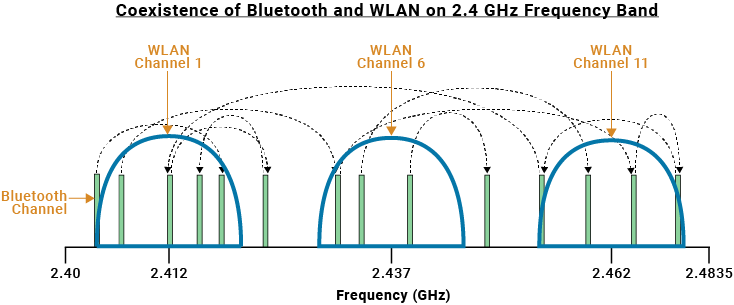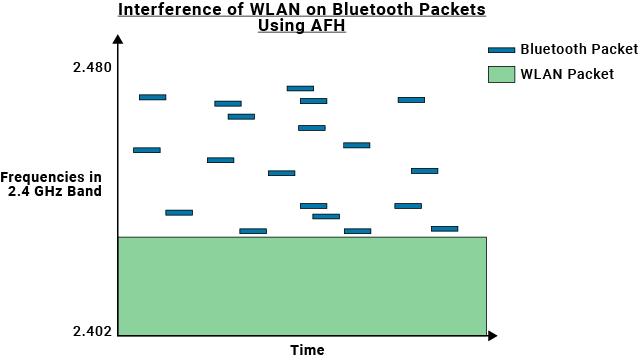Bluetooth-WLAN Coexistence
Due to the ubiquitous deployment of wireless networks and devices on the unlicensed 2.4 GHz Industrial, Scientific, and Medical (ISM) frequency band, multiple homogenous and heterogeneous networks (Bluetooth®, Wi-Fi®, and ZigBee®) operating in this band are likely to coexist in a physical scenario. The wireless personal area network (WPAN) represented by Bluetooth [1] and wireless local area network (WLAN) represented by IEEE® 802.11™ operate in the 2.4 GHz ISM frequency band. Bluetooth and WLAN radios often operate in the same physical scenario and sometimes in the same device. In these cases, Bluetooth and WLAN transmissions can interfere with each other, affecting the performance and reliability of both networks.
IEEE 802.15.2 Task Group [3] considers proposals for ways to improve the level of coexistence between Bluetooth and WLAN devices and publishes the recommended practices derived from these.
Bluetooth and IEEE 802.11 WLAN Specifications
Bluetooth technology uses low-power radio frequencies to enable short-range communication. Bluetooth is equated with the implementation specified by the Bluetooth Core Specification [2] group of standards maintained by the Bluetooth Special Interest Group (SIG) industry consortium. Bluetooth Toolbox enables you to model Bluetooth low energy (LE), Bluetooth LE mesh, and Bluetooth basic rate/enhanced data rate (BR/EDR) communications system links, as specified in the Bluetooth Core Specification. Bluetooth BR/EDR and Bluetooth LE devices operate in the unlicensed 2.4 GHz ISM frequency band.
The Bluetooth BR mode is mandatory and the EDR mode is optional. The Bluetooth BR/EDR radio implements a 1600 hops/sec frequency-hopping spread spectrum (FHSS) technique. The radio hops pseudo-randomly on 79 designated Bluetooth channels. Each Bluetooth channel has a bandwidth of 1 MHz. Each frequency is located at (2402 + k) MHz, where k is an integer between 0 and 78, inclusive. The modulation techniques for the BR and EDR modes are Gaussian frequency shift-keying (GFSK) and differential phase shift-keying (DPSK), respectively. The baud rate is 1 Msymbols/s. The Bluetooth BR/EDR radio uses the time division duplex (TDD) topology, in which data transmission occurs in one direction at one time. The transmission alternates in two directions, one after the other.
In Bluetooth LE, the operating band is divided into 40 channels, k = 0, 1, …, 39, with a channel bandwidth of 2 MHz. The range of RF center frequencies is [2402, 2480] MHz. The user data packets are transmitted using channels in the range [0, 36]. The advertising data packets are transmitted on channels 37, 38, and 39. Bluetooth LE also uses GFSK modulation. The Bluetooth LE physical layer (PHY) uses FHSS to reduce interference and to counter the impact of fading channels. The time between frequency hops can vary from 7.5 ms to 4 s and is set at the connection establishment for each Peripheral with the Central. The Central device provides the synchronization reference. The Peripheral device synchronizes to the clock and frequency-hopping pattern of the Central device. The support for the data rate at 1 Mbps is mandatory for specification version 4.x compliant devices. At a data rate of 1 Mbps, the data transmission is uncoded. Optionally, devices compliant with the Bluetooth Core Specification 5.x support these additional data rates:
Coded transmission at bit rates of 500 kbps or 125 kbps
Uncoded transmission at a bit rate of 2 Mbps
To explore the Bluetooth BR/EDR and Bluetooth LE protocol stack, see Bluetooth Protocol Stack. For information about different packet structures implemented in Bluetooth BR/EDR and Bluetooth LE transmissions, see Bluetooth Packet Structure. To study the fundamentals of Bluetooth mesh networking and its applications, see Bluetooth Mesh Networking.
The IEEE 802.11 (Wi-Fi) standard is a wireless technology that connects devices and an infrastructure in a WLAN. WLAN is compliant with various IEEE 802.11 standards. Some of the prominent and widely implemented standards are 802.11 a/b/g/n/ac/ax/be. The 802.11a standard uses the 5 GHz unlicensed national information infrastructure (U-NII) band and provides at least 23 nonoverlapping 20 MHz wide channels instead of the three nonoverlapping 20 MHz-wide channels offered by the 2.4 GHz band. The 802.11ac standard also operates only in the 5 GHz frequency band. Per Part 15 of the U.S. Federal Communications Commission (FCC) Rules and Regulations, 802.11b, 802.11g, and 802.11n standards use the 2.4 GHz band. Devices that use these standards suffer interference in the 2.4 GHz band from Bluetooth devices. To mitigate this interference, devices that use 802.11b, 802.11g, or 802.11n standards implement direct-sequence spread spectrum (DSSS), Orthogonal Frequency-Division Multiplexing (OFDM), and multiple-input, multiple-output (MIMO) OFDM signaling techniques, respectively. Devices that use the 802.11n, 802.11ax, (Wi-Fi 6) or 802.11be (Wi-Fi 7) standards operate in dual-band at 2.4 GHz and 5 GHz. The 802.11ax standard enhances the existing 802.11 a/b/g/n/ac standards even if they are not fully upgraded to 802.11ax. The OFDM-based channel access technique of the 802.11ax standard is completely backward-compatible with traditional enhanced distributed channel access/carrier-sense multiple access (EDCA/CSMA). IEEE 802.11ax provides maximum compatibility, coexisting efficiently with 802.11a/n/ac devices. 802.11be builds on the advances of 802.11ax.
For more information about WLAN radio frequency channels, see WLAN Radio Frequency Channels (WLAN Toolbox). For more information about WLAN packet structures, see WLAN PPDU Structure (WLAN Toolbox) and Packet Size and Duration Dependencies (WLAN Toolbox).
Spread Spectrum Techniques
Bluetooth and WLAN technologies operate using spread spectrum signal structuring. This signal structuring technique enables a narrowband signal, such as a stream of 1s and 0s, to spread across a given frequency spectrum and transform into a wideband signal. Bluetooth devices implement the basic FHSS technique defined in the Bluetooth Core Specification [2]. This basic frequency-hopping technique is modified into an adaptive frequency hopping (AFH) technique to mitigate interference. WLAN devices that operate under the IEEE 802.11b standard use the DSSS technique. In the case of WLAN devices adhering to the IEEE 802.11g standard, there is the provision for an optional "DSSS-OFDM" mode. This mode is an integration of the 802.11a OFDM format with a preamble that is compatible with the 802.11b standard.
FHSS
The basic Bluetooth frequency-hopping technique spreads the narrowband signal by hopping across different channels on the 2.4 GHz frequency spectrum. This figure shows how the FHSS transmits a Bluetooth signal on different frequencies at specific intervals to spread the signal across a relatively wide operating band.

The Bluetooth transmitters and receivers adhere to a specific hopping sequence during a particular session so that the receiver can anticipate the frequency of the next transmission. In this case, Bluetooth makes full use of the 2.4 GHz frequency spectrum.
DSSS
With DSSS, the narrowband data signal is divided and simultaneously transmitted on multiple frequencies within a specific frequency band. This figure shows how the DSSS continually transmits the data signal across different channels.

The DSSS adds redundant data bits known as chips to the data signal to denote 1s and 0s. The ratio of chips to data is called the spreading ratio. Increasing the ratio increases the signal's resistance to interference: if part of the transmission is corrupted, the data can still be recovered from the remaining part of the chipping code. The DSSS technique provides greater transmission rates than FHSS. DSSS also protects against data loss through redundant simultaneous data transmission. However, because DSSS floods the channel with redundant transmissions, it is more vulnerable to interference from Bluetooth devices operating on the same frequency band.
Orthogonal Frequency-Division Multiplexing
OFDM is a flexible, multicarrier modulation technique implemented by IEEE standards 802.11g/n/ac/ax/be. OFDM partitions the channel bandwidth into multiple narrow-band orthogonal subcarriers to carry data. This partitioning enables the removal of guard bands. Therefore, OFDM is bandwidth-efficient. However, because the orthogonal subcarriers are unrelated, they can overlap each other. This figure shows the frequency-domain representation of the orthogonal subcarriers in an OFDM waveform.

The use of narrow-band subchannels (compared to a single wideband channel) helps mitigate channel fading. As each subchannel operates at a low data rate, OFDM is very resistant to intersymbol interference and interframe interference. As data is transmitted simultaneously on multiple orthogonal subcarriers, OFDM can provide very high throughput. To further maximize the throughput, you can use OFDM with MIMO, extended rate physical (ERP), and multiuser (MU) technologies.
Bluetooth-WLAN Coexistence Problem
Since Bluetooth and WLAN devices both operate in the 2.4 GHz band, a mutual interference exists between the two wireless networks. This interference results in performance degradation. For example, consider the scenario shown in this figure. The scenario consists of two Bluetooth piconets collocated with a WLAN.

If the transmission in piconet 1 overlaps in time and frequency with transmissions from piconet 2 and/or the WLAN, a Bluetooth packet can be lost. This figure shows how the Bluetooth and WLAN devices share the 2.4 GHz frequency spectrum.

If the Bluetooth packet transmitted through the FHSS hops to the portion of the frequency spectrum occupied by the DSSS WLAN transmitter, mutual interference occurs. This interference results in packet collisions. Factors such as the distance between WLAN and Bluetooth devices, the data traffic present in the two networks, power levels of the devices, and data rate of the WLAN network affect the level of interference. Additionally, different types of data traffic have different levels of sensitivity to the interference. For example, voice traffic is more sensitive to interference than data traffic in some situations.
Bluetooth in Presence of 802.11b WLAN Interferer
A transmission that uses one spread spectrum technique interferes with a receiver that uses a different spread spectrum technique. 802.11b WLAN devices operate in a 22 MHz bandwidth. In Bluetooth, 22 of the 79 hopping channels are subject to interference. A frequency-hopping system like Bluetooth is vulnerable to interference from the adjacent channels as well. This vulnerability increases the total number of interference channels from 22 to 24. Based on these assumptions, the results shown in [3] quantify the packet error rate (PER) in Bluetooth transmissions with a 802.11b WLAN interferer. The results show that the network throughput decreases and network delay increases for Bluetooth in the presence of 802.11b interference.
802.11b WLAN in Presence of Bluetooth Interferer
When a Bluetooth device hops into the 802.11b passband, a packet collision can occur with the WLAN device. This collision occurs because 22 of the 79 Bluetooth channels fall within the WLAN passband. Since 802.11b devices support four data rates (1, 2, 5, and 11 Mbps), the transmission time of the WLAN packets may vary significantly for packets carrying the exact same data. Increasing the duration of the WLAN packet increases the likelihood that the packet collides with an interfering Bluetooth packet. If automatic data rate scaling is implemented and enabled in the WLAN device, the Bluetooth interference can cause the WLAN device to scale to a lower data rate. The lower data rate increases the temporal duration of the WLAN packets. This increase in packet duration can lead to frequent packet collisions with the interfering Bluetooth packets. In some implementations, the frequent packet collisions can result in WLAN scaling down its data rate to 1 Mbps. In this case, to ensure reliable packet delivery, the IEEE 802.11 medium access (MAC) layer incorporates an acknowledgement (ACK) and retransmission mechanism.
Coexistence Mechanisms
Interference between Bluetooth and WLAN can be addressed by two coexistence mechanisms – noncollaborative and collaborative.
Noncollaborative Coexistence
Noncollaborative mechanisms do not exchange information between the two wireless networks. These coexistence mechanisms are applicable only after a WLAN or Bluetooth piconet is established and the data is to be transmitted. These coexistence mechanisms do not help in the process of establishing a WLAN or Bluetooth piconet. As per the recommended practices mentioned in [3], these noncollaborative coexistence mechanisms are used to mitigate interference between Bluetooth and WLAN.
Adaptive frequency hopping (AFH) — Prior to the emergence of AFH, Bluetooth devices implemented the basic FHSS signal structuring scheme. The FHSS scheme often results in Bluetooth and WLAN packet transmissions interfering with each other, as shown in this figure.

On the other hand, AFH enables Bluetooth to adapt to its environment by identifying fixed sources of WLAN interference and excluding them from the list of available channels. This figure shows the previous scenario with AFH enabled.

AFH dynamically alters the frequency hopping sequence to avoid interference. AFH operates through these four processes.
AFH capability discovery: this process informs the Central about the Peripheral(s) that support AFH and the associated parameters.
Channel classification: this process classifies the channels as good or bad. Channel classification takes place in the Central and optionally in the Peripheral(s).
Channel classification information exchange: this process uses AFH link manager protocol (LMP) commands to exchange information between the Central and the supporting Peripheral(s) in the piconet.
Adaptive hopping: this process adaptively selects good channels for frequency hopping.
For more information about how AFH mitigates interference and enables coexistence between Bluetooth and WLAN, see PHY Simulation of Bluetooth BR/EDR and LE in Presence of Bluetooth, 5G NR, or WLAN Interference.
Note
For more information about AFH, see Annex B of IEEE 802.15.2 Task Group [3].
Adaptive interference suppression — This mechanism is exclusively related to signal processing in the WLAN physical layer (PHY). The adaptive interference suppression mechanism requires a Bluetooth receiver collocated with a WLAN receiver. The WLAN receiver has no prior knowledge of the timing or frequency used by the Bluetooth network. The WLAN receiver uses an adaptive filter to estimate and cancel the interfering signal.
Note
For more information about adaptive interference suppression, see Clause 8 of IEEE 802.15.2 Task Group [3].
Adaptive packet selection and scheduling — Bluetooth transmissions involve various packet types, with different properties such as packet length and degree of error protection used. By selecting the best packet type according to the channel condition of the upcoming frequency hop, networks can achieve better throughputs. Additionally, packet transmissions can be scheduled efficiently so that the Bluetooth devices transmit during hops that are outside of the WLAN frequencies and refrain from transmitting while in-band. This type of packet transmission scheduling minimizes mutual interference and also increases the throughput of Bluetooth networks.
Note
For more information about adaptive packet selection and scheduling, see Clause 9 of IEEE 802.15.2 Task Group [3].
Packet scheduling for synchronous connection-oriented (SCO) links — Voice applications are among the most sought-after applications for Bluetooth devices but are vulnerable to interference. Interference from an in-band WLAN network degrades the voice quality of the Bluetooth SCO link, making it inaudible to the users. This noncollaborative coexistence mechanism recommends improvements that can significantly improve the quality-of-service (QoS) for SCO links. The fundamental idea is to give the SCO link the flexibility of selecting hops that are out-of-band with the collocating WLAN spectrum for transmission. The duty cycle of the SCO link does not change.
Note
For more information about packet scheduling for SCO links, see Annex A of IEEE 802.15.2 Task Group [3].
Packet scheduling for asynchronous connection-oriented logical (ACL) links — This mechanism defines a procedure to minimize the impact of WLAN interference on Bluetooth devices by using these two components.
Channel classification: It is performed at every Bluetooth receiver and is based on the measurements conducted per frequency or channel to locate the presence of interference. A channel is considered good if it can correctly decode a received packet. Otherwise, the channel is considered bad. Good and bad channels are classified based on criteria such as the received signal strength indicator (RSSI), PER, or negative ACKs.
Central delay policy: It uses the information available in the channel classification table to avoid packet transmission in a bad channel. Because the Central device controls and manages all transmissions in a piconet, the delay rule must be implemented only in the Central device. Also, a Peripheral transmission must follow each Central transmission. Therefore, the Central checks the receiving frequency of the Peripheral and its own receiving frequency before choosing to transmit a packet in a given frequency hop.
Note
For more information about packet scheduling for ACL links, see Clause 10 of IEEE 802.15.2 Task Group [3].
Collaborative Coexistence
In collaborative coexistence mechanisms, two wireless networks collaborate and exchange network-related information. Per the recommended practices stated in [3], the three collaborative coexistence mechanisms are:
Alternating wireless medium access (AWMA) — In the AWMA mechanism, a WLAN radio and a Bluetooth radio are collocated in the same physical unit, enabling a wired connection between the two radios. The collaborative coexistence mechanism uses this wired connection to coordinate access to the wireless medium between WLAN and Bluetooth. The AWMA mechanism uses part of the wireless IEEE 802.11 beacon interval for the Bluetooth operations. From a timing perspective, the medium assignment alternates between usage following the IEEE 802.11 procedures and usage following the Bluetooth procedures. Each wireless network limits its transmissions to the appropriate time segment, thus preventing mutual interference between the two networks.
Note
For more information about AWMA, see Clause 5 and Annex I of IEEE 802.15.2 Task Group [3].
Packet traffic arbitration (PTA) — In the PTA mechanism, the WLAN station and the Bluetooth device are collocated. The PTA control entity provides per-packet authorization of all transmissions. This mechanism can deny permission for transmission if it has a chance to collide. The PTA mechanism dynamically coordinates sharing of the wireless medium based on the traffic load of WLAN and Bluetooth. If a collision occurs, the PTA mechanism prioritizes transmission based on the priorities of different packets. The PTA mechanism should be used in the case of high variability in the WLAN and Bluetooth traffic load, or whenever a Bluetooth SCO link needs to be supported.
Note
For more information about PTA, see Clause 6 and Annex J of IEEE 802.15.2 Task Group [3].
Deterministic interference suppression — In this mechanism, a null is inserted in the WLAN receiver at the frequency of the Bluetooth signal. Because Bluetooth devices hop to a new frequency for each packet transmission, the WLAN receiver must know the hopping pattern and timing of the Bluetooth device. The hopping pattern and timing is obtained by using a Bluetooth receiver as part of the WLAN receiver. Deterministic interference suppression is a collocated, collaborative coexistence mechanism.
Note
For more information about deterministic interference suppression, see Clause 7 and Annex K of IEEE 802.15.2 Task Group [3].
References
[1] Bluetooth Technology Website. “Bluetooth Technology Website | The Official Website of Bluetooth Technology.” Accessed December 17, 2021. https://www.bluetooth.com/.
[2] Bluetooth Special Interest Group (SIG). "Bluetooth Core Specification." Version 5.3. https://www.bluetooth.com/.
[3] P802.15.2/D09 - IEEE Draft Recommended Practice for Information Technology Telecommunications and Information Exchange Between Systems Local and Metropolitan Area Networks Specific Requirements - Part 15.2: Coexistence of Wireless Personal Area Networks With Other Wireless Devices Operating in Unlicensed Frequency Bands. LAN/MAN Standards Committee, IEEE Computer Society, 2003, https://ieeexplore.ieee.org/document/4040972.
[4] Macleod, M D. “14 - Coding.” In Telecommunications Engineer’s Reference Book, edited by Fraidoon Mazda, 14–1. Butterworth-Heinemann, 1993. https://www.sciencedirect.com/science/article/pii/B9780750611626500204.
[5] Xiao, Yang, and Yi Pan. “Coexistence of Bluetooth Piconets and Wireless LAN.” In Emerging Wireless LANs, Wireless PANs, and Wireless MANs: IEEE 802.11, IEEE 802.15, 802.16 Wireless Standard Family, 151–85. Wiley, 2009. https://ieeexplore.ieee.org/abstract/document/8040602.
[6] “IEEE SA - The IEEE Standards Association - Home.” Accessed May 4, 2020. https://standards.ieee.org/.
[7] IEEE Std 802.11ax™-2021 (Amendment to IEEE Std 802.11-2020). “Part 11: Wireless LAN Medium Access Control (MAC) and Physical Layer (PHY) Specifications. Amendment 1: Enhancements for High Efficiency WLAN.” IEEE Standard for Information Technology — Telecommunications and Information Exchange between Systems. Local and Metropolitan Area Networks — Specific Requirements.
See Also
Topics
- Simulate Noncollaborative Coexistence of Bluetooth LE, Bluetooth BR/EDR, and WLAN Networks
- Explore Bluetooth LE and WLAN Coexistence in 6 GHz with LBT
- Collaborative Coexistence of Bluetooth LE, BR/EDR, and WLAN Using PHY Packet Traffic Arbitration
- Noncollaborative Bluetooth LE Coexistence with WLAN Signal Interference
- PHY Simulation of Bluetooth BR/EDR and LE in Presence of Bluetooth, 5G NR, or WLAN Interference